Great white trillium, Trillium grandiflorum, with its bright showy flowers appearing in the spring, is a herbaceous perennial plant native to the forests of eastern North America. Other common names include: large white trillium and white trillium.
Flowers
Flowers:
Great white trillium, Trillium grandiflorum, like other trilliums has flower parts of 3 or multiples of 3. The flower has 3 petals, 3 sepals, a 3 parted stigma, 6 stamens and a whorl of 3 leaves just below the flower. The bright white flower is about 2-3 inches across. The white petals are usually wavy at the margins, of variable width, and pointed at the tip. The funnel shaped corolla petals are tight at the base and flare out above the middle and recurve (bend back). The petal's upper surface has conspicuous veins. The petal margins overlap at the base. The ovary and base of the style are in the corolla funnel and hard to see. Trillium offers pollen. The main pollinators are bees and wasps,
Flower: petals with wavy edges and conspicuous veins.
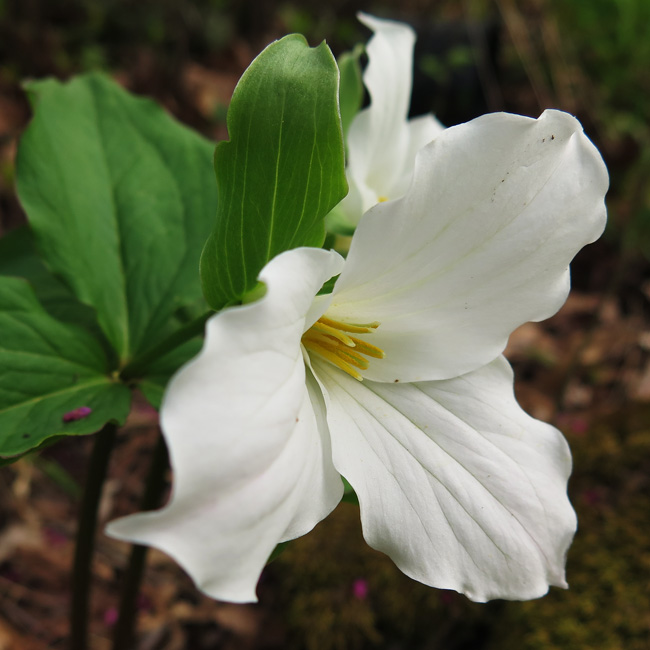
Flower with its 3 narrow sepals and its whorl of 3 leaves below it. The leaves are technically bracts but are referred to as either leaves or bracts.
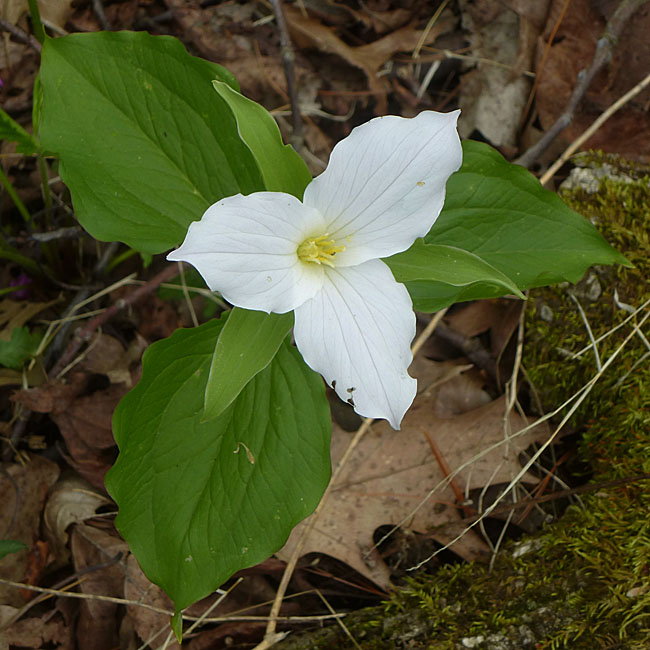
Flower with yellow pollen released from the anthers.
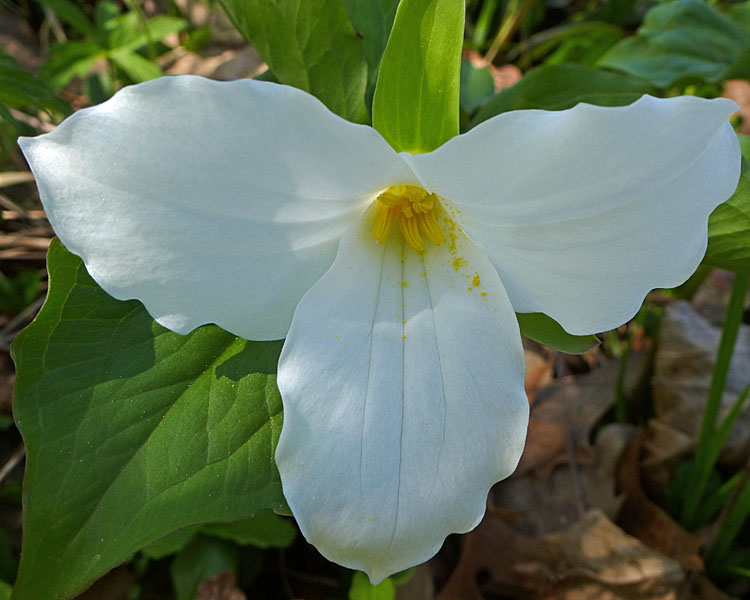
Flower closeup:
6 stamens with greenish white filaments and greenish white anthers between the anther sacs. The anther sacs are not fully mature yet.
The white narrow 3 parted stigma is attached to a whitish sharply 6 lobed, ridged ovary.
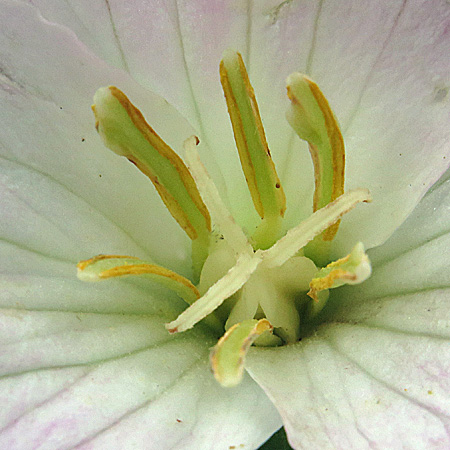
Flower closeup:
The anther sacs are yellow, and dehisce introrsely, meaning the anthers open and release their pollen mainly toward the center of the flower.
The white 3 parted stigma and lobed ovary can be seen.
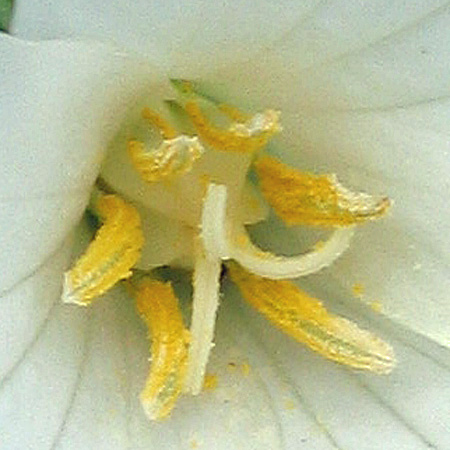
Flower closeup: Both sides of the anthers with pollen covering most of the side facing the center of the flower and the edges where some of the pollen can be seen from the back side.
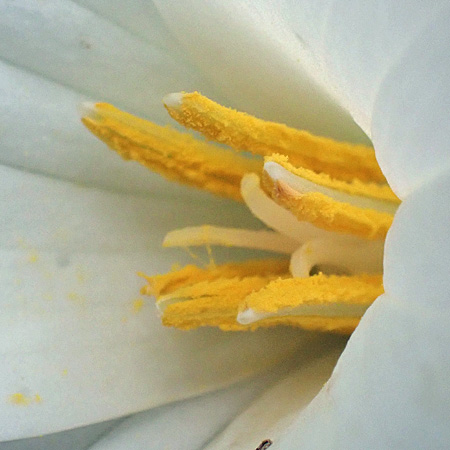
Flower closeup: The stigma here is 4 parted and reddish! The stigma is fused at the base.
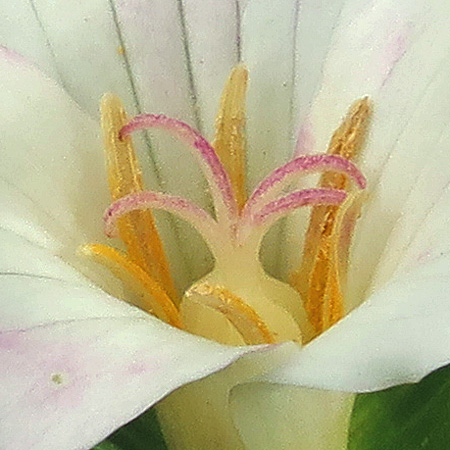
Side view:
Corolla is funnel shaped with petals flaring out and recurved (bending backwards).
The sepals narrow to a point.
The erect pedicel (flower stalk) is slightly bent so that the flower faces slightly horizontal. The pedicel is 2 to 3 inches long
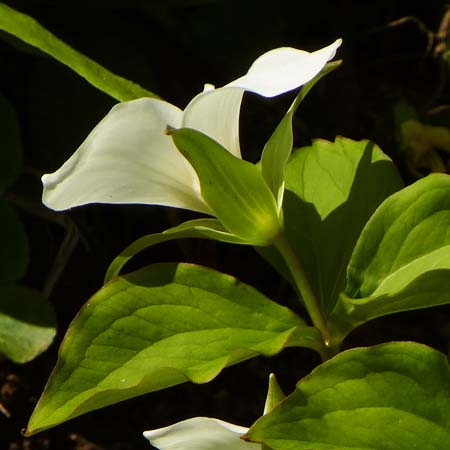
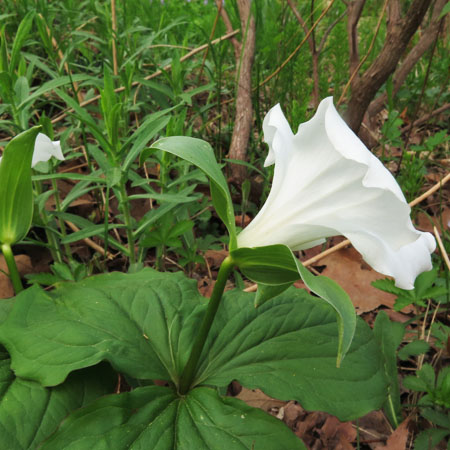
The flower turns pinkish with age.
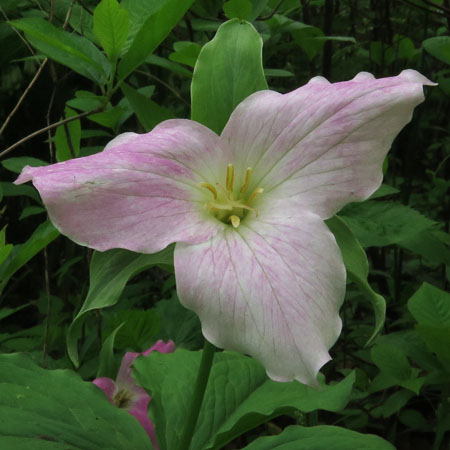
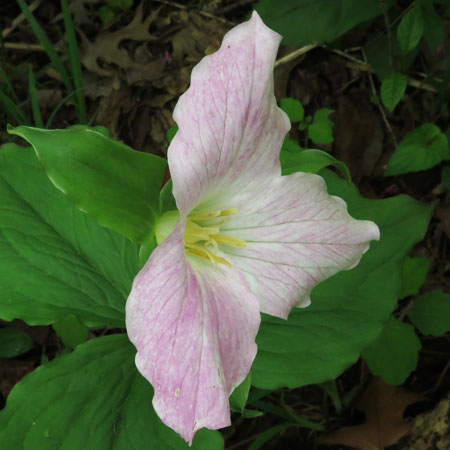
Fruit
Fruit:
The fruit is pale green slightly 6 angled, roundish and is about 1/2 inch long.
Like many spring flowers, the trillium seeds have attachments called elaiosomes that are high energy food for the ants. Ants carry the seeds back to their nest, eat the elaiosomes, and discard the seeds in their waste area where the seeds will eventually germinate. This is called myrmecochory.
Leaves
Leaves:
The whorl of 3 leaves just below the flowers are technically bracts. Some literature refer to them as leaves and others as bracts. They are dark green and are sessile or almost sessile and 3 to 6 inches long. The leaves are broadly ovate (wider below the mid-length) and pointed with prominent veins.
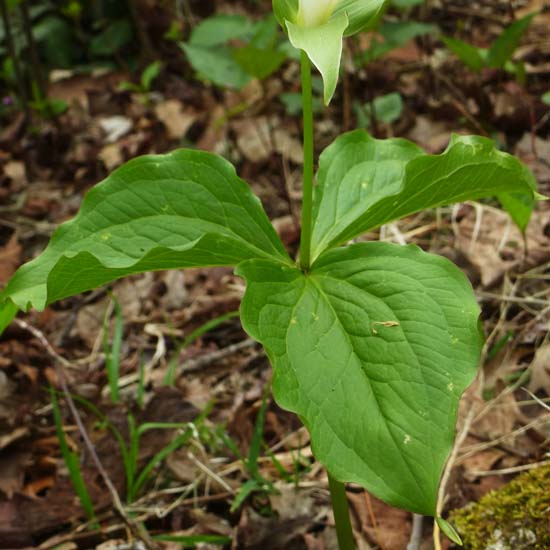
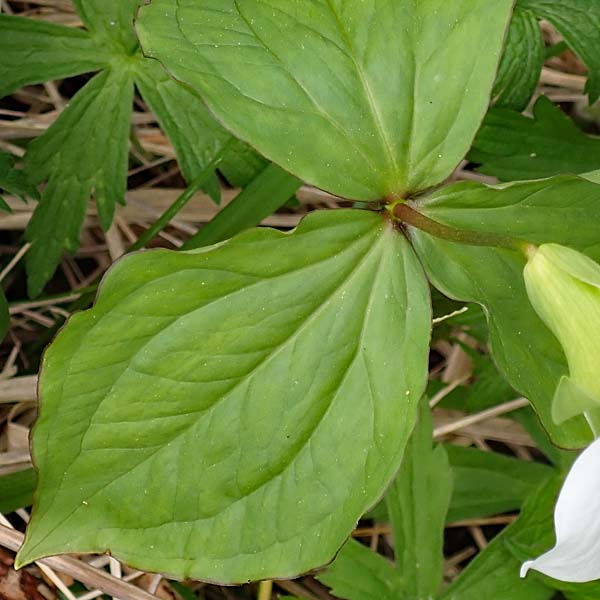
Plant & Habitat
The great white trillium plant has one unbranched stalk which is topped by the single terminal flower just above a 3-leaf whorl. The plant can be 15 inches tall or more. The stalk emerges from a short thick rhizome which is a specialized underground horizontal stem. Rarely, more than one flower stalk emerges from a rhizome. Interestingly the flower stalk is technically an extension of the rhizome and is termed a scape in some of the literature.
The great white trillium flowers from late April to early June depending on location. The habitats include rich deciduous or mixed coniferous-deciduous woods.
Unfortunately, with the increasing population of the white-tailed deer, the populations of the trillium have been decreasing.
Trillium life cycle: Trilliums are known to take years to bloom starting from seed going through several stages. (See Tyron reference below.)
-
Cotyledon stage:
The seeds mature in the summer. For Trillium grandiflorum germination does not begin until after the first winter and during the next spring the first root, radical, will form. After the next winter (2nd winter) the cotyledon will form. Germination may vary for different trillium species. Since trilliums are monocots, they have a single cotyledon leaf. The plant will remain in this stage for only one whole summer. -
One leaf stage:
The plant will spend one or more summers in this stage. This one leaf is less than a inch long and looks like a leaf. -
Three leaf stage no flower:
The leaves look like trillium leaves. The plant will be in this stage at least one year without any flowers. It may be in this stage for more than one year. The leaf will photosynthesize to grow the rhizome below. -
Three leaf stage with flower:
The plant may remain in this stage or cycle back and forth with the 3 leaf no flower stage. - Dormancy: Plants in the 3 leaf with/without flower stages may go in and out of dormancy.
The great white trillium may easily take 10 years to bloom. Cultivated plants will flower earlier. If the rhizome is not disturbed, it can be long-lived.
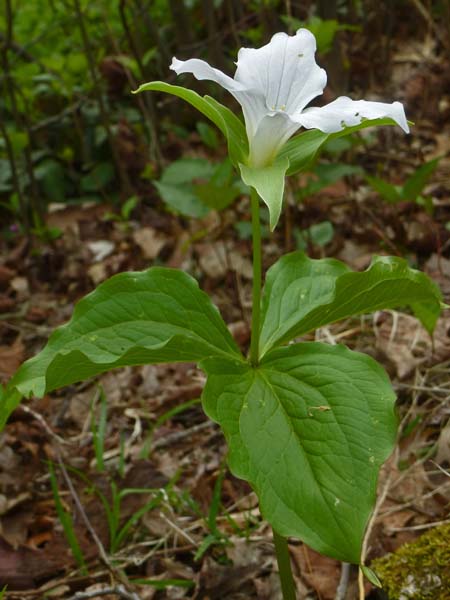
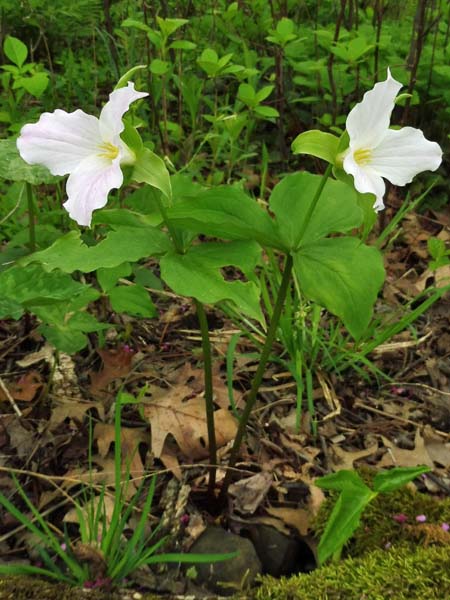
A large natural population in Great Smokey National Park
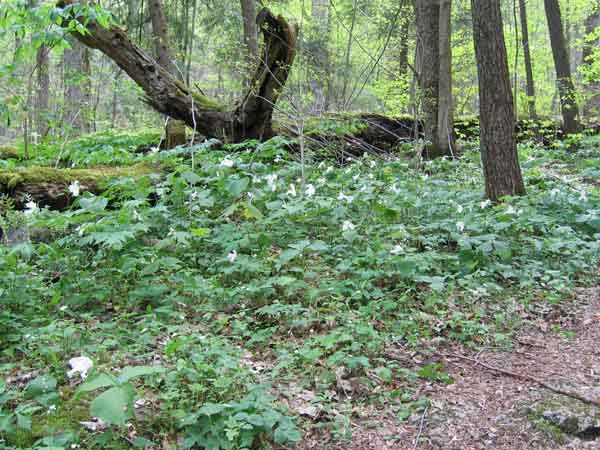
Rarity: In NJ, the great white trillium is S1 (critically imperiled). Globally it is secure, G5, although in many states it is rare. There can be large populations in some areas.
There are 43 species of Trillium world wide, 38 are in North America mostly in the eastern states. New Jersey has only 4. The 4 NJ native trilliums are:
- T. erectum (red trillium)
- T. cernuum (nodding trillium)
- T. grandiflorum (great white trillium)
- T. undulatum (painted trillium)
Weakley's key to the Trilliums. It is interesting to see the features that separate the species. Weakley's key is limited to the Southern NJ and Southeast so that there are fewer plants but large enough coverage to include other trilliums you may come across. This in turn, makes the key simpler than a key that covers all North America.
For Trillium grandiflorum:
- Flowers are pedicellate - stalk between flower and whorl of leaves (vs. sessile - no stalk)
- Petals are wavy margined, relatively delicate texture, ovary greenish white (vs. straight margins, thicker texture, ovary dark to white). Key C.
- Petals white to pink, no red blaze, anther sacs yellow, dehiscence introrse ( vs. petals white with red blaze, anther sacs lavender to white, dehiscence extrorse - Painted Trillium )
- Flower stalk (pedicel) erect and flower remains above the leaves (vs. the stalk bends down so that the flower is below the leaves - Catesby's Trillium )
- Sepals narrower than petals, acute; anthers white to greenish white between the anther sacs; pedicel off angled from vertical (vs. T. pusillum complex)
- Ovary sharply 6 angled; leaves greater than 2 inches long and pointed. (vs. T. nivale)
- Petals are obovate (widest above the middle lengthwise), narrow funnel shape at the base, flaring sharply toward the tip. (vs. T. persistens)
Text by Millie Ling and all photos by Hubert & Millie Ling. Photos: Cultivation May, Great Smoky Mt. NP April.
Additional information / References
Additional information / references:
- Flora of North America: Trillium grandiflorum https://floranorthamerica.org/Trillium_grandiflorum
- Minnesota Wildflowers Trillium grandiflorum https://www.minnesotawildflowers.info/flower/large-flowered-trillium
- USDA Forest Service Plant of the Week: Trillium grandiflorum https://www.fs.usda.gov/wildflowers/plant-of-the-week/trillium_grandiflorum.shtml
-
Tyron Naturalist Notes: Trillium: The Princess of the Forest
Excelent description of life cycle of trilliums and with photos. https://tryoncreek.wordpress.com/2016/03/29/trillium-the-princess-of-the-forest/ - Weakley: Flora of the Southern and Mid-Atlantic States: key to trilliums, pg 164: downloadable, https://ncbg.unc.edu/wp-content/uploads/sites/963/2019/04/WeakleyFlora_2015-05-29.pdf
- NatureServe: Trillium grandiflorum https://explorer.natureserve.org/Taxon/ELEMENT_GLOBAL.2.152039/Trillium_grandiflorum